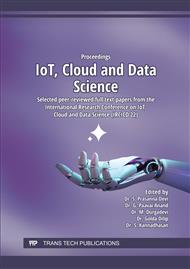[1]
Md. Rakibul Islam, Detection of COVID-19 from CT Image by The Novel LeNet-5 CNN Architecture,, 2020 23 rd International Conference on Computer and Information Technology (ICCIT), 19-21 December, (2020).
DOI: 10.1109/iccit51783.2020.9392723
Google Scholar
[2]
Areej A. Wahab Ahmed Musleh,COVID-19 detection in X-ray Images using CNN,, Algorithm 2020 International Conference on Promising Electronic Technologies (ICPET), 978-0-7381-1139-1/20/$31.00 ©2020 IEEE DOI 10.1109/ICPET51420.2020.00010.
DOI: 10.1109/icpet51420.2020.00010
Google Scholar
[3]
Ram Murti Rawat, COVID-19 Detection using Convolutional Neural Network Architectures based upon Chest X-rays,,Images Proceedings of the Fifth International Conference on Intelligent Computing and Control Systems (ICICCS 2021) IEEE Xplore Part Number: CFP21K74-ART; ISBN : 978-0-7381-1327-2.
DOI: 10.1109/iciccs51141.2021.9432134
Google Scholar
[4]
Sara Hosseinzadeh Kassani, Automatic detection of coronavirus disease (COVID-19) in X-ray and CT images ,0168-8227/Ó,2020 Nalecz Institute of Biocybernetics and Biomedical Engineering of the Polish Academy of Sciences. Published by Elsevier.
Google Scholar
[5]
Wentao Zhao, Deep learning for COVID-19 detection using Radiology Modalities, Hindawi Journal of Healthcare Engineering Volume 2021,Article ID 6677314.
Google Scholar
[6]
Mustafa Ghaderzadeh, Deep Learning in the detection based on CT images, School of Intelligent Transportation, Zhejiang Institute of Mechanical & Electrical Engineering, Hangzhou 310053, vChina.https://doi.org/10.1038/s41598-021-9 3832-2.
Google Scholar
[7]
Fian Yulio Santoso, A Modified Deep Convolutional Network for COVID-19 detection based on chest X-ray images,, 2020 3rd International Seminar on Research of Information Technology and Intelligent Systems 978-1-7281-840-6-7/20.
DOI: 10.1109/isriti51436.2020.9315479
Google Scholar
[8]
Moutaz Alazab, COVID-19 Prediction and Detection Using Deep Learning, , International Journal of Computer Information Systems and Industrial Management Applications. ISSN 2150-7988 Volume 12 (2020) pp.168-181.
Google Scholar
[9]
Tatiana Chakravorti,Detection and Classification of COVID 19 using Convolutional Neural Network from Chest X-ray Images,, 2021 6th International Conference for Convergence in Technology (I2CT)Pune, India. Apr 02-04, (2021).
DOI: 10.1109/i2ct51068.2021.9418221
Google Scholar
[10]
Sammy V. Militante, Pneumonia and COVID-19 Detection using Convolutional Neural Networks,, 2021 the third International Conference on Vocational Education and Electrical Engineering (ICVEE).
DOI: 10.1109/icvee50212.2020.9243290
Google Scholar
[11]
Pedro R. A. S. Bassi, A deep convolutional neural network for COVID-19 detection using chest X-rays,, Department of Computer Engineering and Industrial Automation, School of Electrical and Computer Engineering, University of Campinas, Campinas, Brazil.
Google Scholar
[12]
Taban Majeed, Shallow Convolutional Neural Network for COVID-19 Outbreak Screening Using Chest X-rays, ,Department of Computer Science and Information Technology, Salahaddin University, Erbil, Kurdistan Region, Iraq.
DOI: 10.46717/igj.55.2d.13ms-2022-10-29
Google Scholar
[13]
Ai T, Yang Z, Hou H, Zhan C, Chen C, Lv W, Tao Q, Sun Z, Xia L. Correlation of chest CT and RT-PCR testing in coronavirus disease 2019 (COVID-19) in China: a report of 1014 cases. Radiology 2020:200642.
DOI: 10.1148/radiol.2020200642
Google Scholar
[14]
Lauer SA, Grantz KH, Bi Q, Jones FK, Zheng Q, Meredith HR, Azman AS, Reich NG, Lessler J. The incubation period of coronavirus disease 2019 (COVID-19) from publicly reported confirmed cases: estimation and application. Ann Intern Med 2020;(2019).
DOI: 10.1101/2020.02.02.20020016
Google Scholar
[15]
Jibril SIAML, Islam Md M, Sharif US. Predictive data mining models for novel coronavirus (COVID-19) infected patients recovery. SN Comput Sci 2020;1:206.
DOI: 10.1007/s42979-020-00216-w
Google Scholar
[16]
Li Y, Xia L. Coronavirus disease 2019 (COVID-19): role of chest CT in diagnosis and management. AJR Am J Roentgenol 2020;1–7. https://doi.org/10.2214/ AJR.20.22954.
Google Scholar
[17]
Fang Y, Zhang H, Xie J, Lin M, Ying L, Pang P, Ji W. Sensitivity of chest CT for COVID-19: comparison to RT-PCR, Radiology. 200432, https://doi.org/10.114 8/radiol.2020200432; (2020).
DOI: 10.1148/radiol.2020200432
Google Scholar
[18]
Thevenot J, Lopez MB, Hadid A. A survey on computer vision for assistive medical diagnosis from faces. IEEE J Biomed Health Inf 2018;22:1497–511. https://doi. org/10.1109/JBHI.2017.2754861.
DOI: 10.1109/jbhi.2017.2754861
Google Scholar


